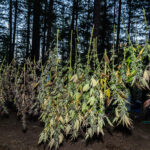I’m about five minutes late to my interview with Harborside Health Center Executive Director Steve DeAngelo, who’s been holed up in his suite at the Encore at Wynn conducting nonstop meetings while the MJBiz Vegas show is in full swing. I’d never conversed at length with DeAngelo, a legendary cannabis activist and entrepreneur, but I’d heard him speak many times over the past several years and I’d reviewed his 2015 book, The Cannabis Manifesto: A New Paradigm for Wellness.
I knew the man was outspoken and ready to take on all comers, including those within the industry with whom he has profound disagreements. That dynamic is currently in play in the form of an ongoing public debate with California Growers Association Executive Director Hezekiah Allen over California’s removal of grow size restrictions. DeAngelo supports and Allen opposes the controversial move the Department of Food and Agriculture had not yet announced when DeAngelo and I sat down in Vegas. Not surprisingly, however, the issues underlying his positions on grow sizes and other related subjects were very much on both our minds that day and formed the basis of our discussion.
DeAngelo is tall, handsome, and gracious, with a rich, sonorous voice and consummate command of his thoughts. A skilled public speaker, he is an engaging interview subject and a very good listener, making it a pleasure to converse with him. Despite having no agenda for our interview, the discussion quickly turned to the seminal question of the moment: What is going to happen after January 1, 2018, to the many cannabis businesses currently in the food chain, and especially to the traditional Emerald Triangle farmer? DeAngelo was eager to address the subject.
“We are looking in 2018 and 2019 at an extinction event for 75 percent of the existing cannabis industry in California,” he said, letting the number sink in. “Manufacturers and extractors are going to be hit first, and they’re going to be hit the hardest. The basic reason for that is because, currently, there is not a fully regulated supply chain. Manufacturers and extractors universally source from the black, unregulated market, buying the trim and the smalls that are cut off 90 percent of the cannabis flowers that are shipped out of state. That entire source of supply is cut off when you go to a regulated supply chain. When extractors and manufacturers can only purchase from a licensed cultivator, their available pool of raw material is going to shrink by a factor of nine. They will have one-ninth of material to work with as they do today.”
It gets worse. “Add to that the fact that many people who will be licensed cultivators will have a really hard time producing cannabis that meets the pesticide requirements of the state, which cuts the supply down a bit more,” said DeAngelo. “Then we have to anticipate the same thing will happen in California that happened in Oregon, where there was insufficient lab capacity to test all of the tests that are required, which will be very substantial. In Oregon, some companies had to wait two or three months to get their product tested. For a small company that doesn’t have the margins, that can be the difference between survival and going out of business.”
We’ve seen this movie before, said DeAngelo. “What happened in Oregon was that in the first month of adult use, sales shot up. But in the second, third, fourth months, sales trailed off—not because of a lack of demand, but because of a lack of supply in the legal system. And this will happen here in California, first to the manufacturers and extractors, but then there is going to be this chain effect. Dispensaries are going to be impacted, because they are not going to have the same range of products available at the same prices. So, prices are going to go up, and the amount of selection is going to go down. That’s not good for retailers. Add to that the tax burden that we’re going to have, and a lot of consumers are going to be driven out of the legal market entirely, and they’re going to go back underground.”

California Versus the World
For DeAngelo, the answer is in immediate engagement with the market at a scale that addresses the demands of the market. “You talk to any cannabis consumer in a legal market and ask them what is the biggest problem they have with cannabis, and they will tell you price,” he said. “Here is the flip-side of creating regulations that do not allow for the development of large-scale cannabis agriculture, and Hezekiah and I fought over this, too.”
He uses the heirloom tomato example. “We have heirloom tomatoes and then we have tomatoes that are less expensive and not quite as juicy. What if someone tried to legislate that the only kind of tomatoes that could be sold were heirloom at $6.99 a pound? People would be up in arms. Same thing with cannabis. If you do not allow large-scale cannabis agriculture, the only cannabis on the market will be artisan cannabis, which is great if you can afford to pay for a master gardener growing in a small plot in organic soil, hand-trimmed buds, and curing for two months.
“Here is where I think we should go optimally,” he added. “It should not be a question of small growers versus large growers. It should be California growers versus the growers from other states. This is our heritage, and it is ours to claim. We made the cannabis thing happen in this country, sacrificed for it, and we have the ideal micro-climates necessary for growing cannabis, the best genetics, the best talent, existing big [agricultural] infrastructure, and a good political climate. There is no reason that California should not do with cannabis what it’s done with every other fruit and vegetable, which is claim half the national market when we have interstate commerce.
“Let’s play this out a little bit further,” he continued. “When we have an interstate market and cannabis can be freely traded throughout the states, it will be distributed by companies with a national footprint. These companies will never be interested in 300 pounds of weed, which will then not make it into the national market. And if all we have is small, artisan growers, then we will not access the national market.”
I note that many NorCal growers are actively organizing themselves in a variety of collective models designed specifically to scale up while branding the individual farms. “They have to do that,” he countered, “but there is a limit when you’re talking about a national footprint and building national brands, and the limit to the consistency and volume you can get from those sorts of cooperative arrangements.”
He continued, “So, you have business arrangements between small growers and large growers that allow this amazing artisan talent that we have in California to be scaled up to the point where we can take it out into the national marketplace and win with it. That’s how we should be thinking about this, because here’s how California growers really get hurt. Ninety percent of the growers today will not get into the legal system. We know that. They are dependent upon that national market. If we lose that national market to other companies that have the scale and ability to serve it in other states, we will not get it back.”
People of the North
The prospect of losing 90 percent of anything good is difficult to comprehend, but in this case, it is potentially catastrophic. “This is a place where I have some conflicting and mixed emotions,” DeAngelo said. “This is the culture I come out of. My entire life, I’ve been going up into those hills and pulling cannabis out of them, and I’ve been taking dollars to those communities. I know four generations of families in those hills. Collectively, they are among the people most responsible for bringing us to where we are today with the public acceptance of cannabis, and it was not easy. The people of the northern Emerald Triangle have made the most painful sacrifices people can make. They have been arrested, put on trial, had their houses, bank accounts, and children seized, had their loved ones locked up in cages, and in some cases, they have been killed.”
What is lost if they go away, I asked. “There is the loss of genetics, history, culture, growing techniques,” said DeAngelo. “There is a lot of loss, which is why I have urged my friends in the Emerald Triangle to get legal, because what they have is super valuable. But folks are challenged because a lot of them did not go to the Emerald Triangle to have a huge career and dominate mainstream society. They didn’t really like mainstream society. Now the idea of having to re-engage with society and have a lot of restrictions put on the way they grow cannabis and do things is anathema to the kind of lifestyle people were seeking.
“I get it,” he added, “but times change, and things move on. We, the cannabis culture, the counterculture, have had a profound influence on mainstream culture. I have seen it happen during my lifetime. We have moved it. Anyone who wants to go back to the land, God bless you, but our culture has gotten strong enough so that we can do what I think our hippie ancestors wanted to do in the beginning, which is change the world. We don’t do that by staying on our farms, but by taking our culture, embracing our beliefs and perspective, and bringing it to the world. And that’s what we have now. We’ve been shackled by prohibition and couldn’t tell our stories because we would have been, and were, taken to prison.
“But now we can,” he continued. “So, my hope and plea are that the people who made the Emerald Triangle what it is today have enough confidence in the strength of that culture to go through the hassle it is going to take to become legal. We have a world to save. This plant needs to get into people’s hands We need to do it.”
Besides, he added, “Anyone who wants to be in the cannabis space ten years from now needs to get legal today. That’s not the outcome I want. I just think it’s the reality.”

Harborside Farms
I asked DeAngelo about Harborside Farms—the forty-seven-acre cultivation site in Salinas that contains 360,000 square feet of greenhouse, with about 150,000 square feet currently developed—and whether his intent is for it to serve in that role as a scalable intermediary delivering NorCal cannabis to the world. He nodded. “We have always served the growers of the Emerald Triangle and we have always given them a market, and we intend to continue doing that,” he said. “Our mission will be to help artisan growers scale, and that serves our needs and their needs as well. I can’t tell you the groups I’m working with, because I’m still in negotiations with them, but we’re talking to several organizations in the Emerald Triangle that represent networks of growers. And the basic business deal that we are negotiating with them is that those growers, once they come up with a technique or a genetic that has real market value, can then bring that genetic or technique to us, and we will deploy it at larger scale at our Salinas cultivation facility, and they will get a defined share of that revenue.
“One of the great things about us growing at scale is that we are able to put in the kinds of systems—for security, monitoring, storage, and tracking—that will give growers a higher level of confidence in our ability to safeguard whatever it is of value that they have given to us to develop for them,” he added.
Will Harborside’s mission stay the same? “The mission changes constantly, as we make progress, as we push this thing forward,” he replied. “For example, we’ve always been very dedicated to legal reform. Now I’ve begun talking to people about how, in places like California, we’ve dealt with that part of the problem, but there’s still this horrible, horrible stigma that clings to cannabis. And that stigma is not as clean or as clear as the law to deal with. It resides in these unspoken gaps in conversations and long, lingering judgmental looks and ridiculous regulations and faceless sabotage by bureaucrats, documents that get lost, all that kind of shit. The stigmatization of cannabis predates its prohibition, and it will postdate its legalization. It will continue to harm us and punish us for as long as it is around.
“So, how do we get rid of stigma now that we’ve gotten rid of the law?” he continued. “What did the gay community do? Once the laws started dialing down, that’s when the movement to come out of the closet happened. We know that the best way to win someone over to the cause of cannabis reform is if they know someone personally that they trust, or preferably that they love, who has benefitted from the use of cannabis
“If every high-functioning, responsible, widely respected cannabis consumer came out of the closet tomorrow,” he added, “this thing would be done. It would be finished. It’s time for us to find our courage, claim our dignity, and come out of the fucking closet. The goal is to build a respected place for this plant in every society, not just ours. We’ve got a long way to go. After we dismantle the stigma, we’re going to have to start building the kind of honor and appreciation this plant really deserves.”
The godfather of cannabis is just getting started. “My ambition is that Harborside be as influential in the cannabis industry in its next phase of growth as we have been in bringing it to the day it is now,” he said. “I think we have a unique perspective, and I think we have things to teach the world about cannabis.”
Postscript
As we went to print, the debate continued between DeAngelo and Allen in the form of dueling editorials published on Leafly.com in late December. The latest drama represents a public outbreak of longstanding disagreements on issues that speak to the central concern about how California will manage the end of cannabis prohibition and the creation of a legal market without doing irreparable harm to the NorCal cultivation community and culture. But let’s not sugarcoat the situation. These are not minor disagreements, but fundamental breaks in strategy complete with accusations of malfeasance that question the other’s commitment to the small- to mid-sized grower. Conversely, each claims to be acting in the best interest of the future of the small farmer. Sadly, it feels like a battle for the soul of the NorCal cultivator, but at least it’s being framed in the language of the legal market, which is precisely where the industry needs to be.













[…] California, Mayor Willie Brown Jr. dubbed Steve DeAngelo “the father of the legal cannabis industry”—and for good reason. The redoubtable co-founder […]